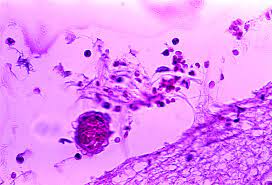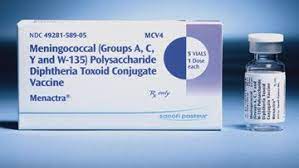Meningitis is the inflammation of brain and spinal cord membranes called meninges. The meninges are the three membranes that are the Dura mater, arachnoid mater, and pia matter that covers the brain and also the spinal cord. Meningitis can occur when fluid surrounding the meninges (three membranes)becomes infected. The most common Primary causes of meningitis include viral infections and bacterial infections, but can also be cancer, chemical irritation, fungi, and drug allergies. Viral and bacterial meningitis are contagious. They can be transmitted by coughing, sneezing, or close contact. Meningitis that involves Dura matter is called patchy meningitis. Meningitis which involves arachnoid and pia matter called Lepto meningitis. Meningitis can be a life-threatening infectious disease because of the inflammation’s proximity to the brain and
spinal cord; therefore the condition is classified as a medical emergency.
MENINGES:
The meninges is the system of membranes that cover the total central nervous system. It consists of 3 layers:
1. Dura mater
2. Arachnoid mater
3. Pia mater
Subarachnoid space – it is a space that is present in between the arachnoid mater and the pia mater, which is filled with cerebrospinal fluid.
MENINGITIS SYMPTOMS:
Viral meningitis
In infants
• Decreased appetite
• Irritability
• Sleepiness
• Lethargy
• Fever
In adults
• Headaches
• Fever
• Stiff neck
• Seizures
• Sensitivity to bright light
• Sleepiness
• Lethargy
• Nausea
• Decreased appetite
Bacterial meningitis
• Altered mental status
• Nausea
• Vomiting
• Sensitivity to light
• Irritability
• Headache
• Fever
• Stiff neck
Clinical features of meningitis
• Chills, rigors, or fever (temperature >38C)
• Neck stiffness(Nuchal rigidity)
• Altered mental status
• Focal neurological effects like hypertonia, hemiparesis, nystagmus
• Seizures
• Headache
• Photophobia
• Nausea and vomiting
• Petechial rash
TYPES OF MENINGITIS AND CAUSES:
Viral infections and bacterial infections are the most common causes of meningitis. There are several other forms of meningitis. Examples include cryptococcal, which is caused by a fungal infection, and carcinomatous, which is cancer-related. These types are rare.
1. Viral Meningitis: Viral meningitis is the most common cause and common type of meningitis. Viruses belonging to the Enterovirus category cause 85 % of cases. Viruses belong the Enterovirus category cause about 10 to 15 million infections per year, but only a small percentage of people who get infected will develop meningitis.
These are more common during the summer and fall, and they include:
• Coxsackievirus A
• Coxsackievirus B
• Echoviruses
Other viruses can cause meningitis. These include:
• West Nile virus
• Influenza
• Mumps
• HIV
• Measles
• Herpes virus
• Coltivirus, which causes Colorado tick fever
2. Bacterial Meningitis: Bacterial meningitis is contagious(communicable )and is caused by infection from certain types of bacteria. It may cause even death if it’s left untreated. Between 5 to 40 % of children and 20 to 50 % of adults with this type of condition will die. This is true even with proper treatment. The most common types of bacteria that are responsible for causing bacterial meningitis include,
• Streptococcus pneumoniae: It is typically found in the respiratory tract,
sinuses and also in the nasal cavity, and can cause meningitis called as
“pneumococcal meningitis”.
• Neisseria meningitides: It is spread through saliva and other respiratory fluids
and causes meningitis called “meningococcal meningitis”.
• Haemophilus influenza: This can cause not only meningitis but also the
infection of the blood, cause inflammation of the windpipe, cellulitis, and
infectious arthritis.
• Listeria monocytogenes: it is foodborne bacteria.
Other causes of Meningitis include,
Fungal
• Cryptococcus
• Cocci diodes
• Histoplasmoses
• Mucormycosis
• Aspergillus
• Candida (yeasts)
Parasitic/protozoal
• Angiostrongylus
• Toxoplasma
• Hydatid
• Amoeba
• Plasmodium
• Cysticercosis
MODE OF TRANSMISSION:
Bacterial meningitis
• The virus and bacteria that causes meningitis can be spread through respiratory
droplets while sneezing, coughing, kissing
• Sharing cigarettes, toothbrushes, or utensils
• Asymptomatic carriers(some people can be infected and carry the disease without showing symptoms being sick)
• People usually contract bacterial meningitis by breathing in tiny particles and saliva
• Crowded settings facilitate transmission like college hostels, crowded households,
night clubs bars, and military barracks.
Viral meningitis
• Transmission of the virus through saliva while sneezing and coughing and through stool.
RISK FACTORS:
1. Compromised Immunity: An immune deficiency is more susceptible to causing
meningitis infections. Certain disorders and treatments can weaken the immune
system. These include:
• HIV
• AIDS
• Autoimmune disorders
• Chemotherapy
• Organ or bone marrow transplants
Cryptococcal meningitis, which is caused by a fungus, is the most common form of meningitis in people with HIV or AIDS.
2. Community Living: Meningitis is easily spread when people live in close quarters. Being in small spaces increases the chance of exposure. Examples of these locations include:
• College dormitories
• Barracks
• Boarding schools
• Day care centers
3. Pregnancy: Pregnant women have an increased risk of developing listeriosis, which is an infection caused by the Listeria bacteria. This type if infection can even spread to the unborn child.
4. Age: All ages are at risk for meningitis. Children under the age of 5 years are at
increased risk of developing viral meningitis. Infants are at higher risk of bacterial
meningitis.
5. Working with Animals: Farmworkers and others who work with animals have an increased risk of infection with Listeria.
6. Diabetes
7. Chronic malnutrition
8. Pneumonia
9. Chronic alcoholism
COMPLICATIONS:
The longer the cause of the disease without treatment, the greater the risk of seizures and permanent neurological damage. The following complications are typically associated with meningitis:
• Seizures
• Hearing loss
• Gait problems
• Memory difficulty
• Learning disabilities
• Brain damage
• Hydrocephalus
• A subdural effusion, or a buildup of fluid between the brain and the skull
• Kidney failure
• Shock
• Death
PREVENTION:
• Maintaining a proper healthy lifestyle
• Getting adequate amounts of rest
• No smoking
• Avoiding contact with sick people
• Vaccinations can also help to protect against certain types of meningitis.
Vaccines that can help to prevent meningitis include the following:
Haemophilus influenza type B (Hib) vaccine
Pneumococcal conjugate vaccine
Meningococcal vaccine
DIAGNOSIS:
1. Physical exam: Physical exams include monitoring of fever, an increased heart rate, neck stiffness, and reduced consciousness can be important clues for the diagnosis of meningitis in the early stage.
2. Lumbar puncture: This test is also known as a spinal tap. It allows checking for
increased pressure in the central nervous system. It can also help to find the
inflammation or bacteria present in the spinal fluid. This test can also help to
determine The best antibiotic for treatment.
3. Blood cultures: Helps for the identification of bacteria in the blood. Bacteria can
able to travel from the blood to the brain. N. meningitides and S. pneumoniae can
cause both sepsis and meningitis.
4. Complete blood count: A complete blood count with differential is an index of
health. It checks the number of red and white blood cells in the blood. White blood cells fight infection. The count is usually elevated in meningitis.
5. Chest X-rays: Chest X-rays can detect the presence of pneumonia, tuberculosis, or fungal infections. Meningitis can occur after pneumonia.
6. CT scan: A CT scan involves the scanning of the head and may show problems like a brain abscess or sinusitis. Bacteria can spread from the sinuses to the meninges.
MENINGITIS TREATMENT:
Bacterial Meningitis or severe viral meningitis may require proper treatment in a hospital, including:
• Medications include antibiotics, corticosteroids, and medicines to reduce fever.
• Oxygen therapy for those patients who have trouble breathing.
• Supportive care. In the hospital, monitor the person closely and provide care if
needed. For example, if the patient may need to drink extra liquids or get fluids in a
vein (IV)
Meningitis Vaccine
The meningococcal vaccine is recommended for people who are at increased risk of meningococcal disease, such as adolescents and young adults, college students living in dormitories, and people with certain medical conditions that put them at increased risk. The vaccine is typically given as a series of two or three doses, depending on the person’s age and other factors.
There are different types of meningococcal vaccines, including MenACWY and MenB. The MenACWY vaccine protects against four different serogroups of meningococcal bacteria (A, C, W, and Y), while the MenB vaccine protects against one specific serogroup (B). Both vaccines are recommended for certain groups of people and can be given at the same time as other vaccines.
It’s important to talk to your healthcare provider about the meningitis vaccine and whether it’s recommended for you or your child. Your healthcare provider can help you understand the risks and benefits of the vaccine and make an informed decision about whether to get vaccinated.


